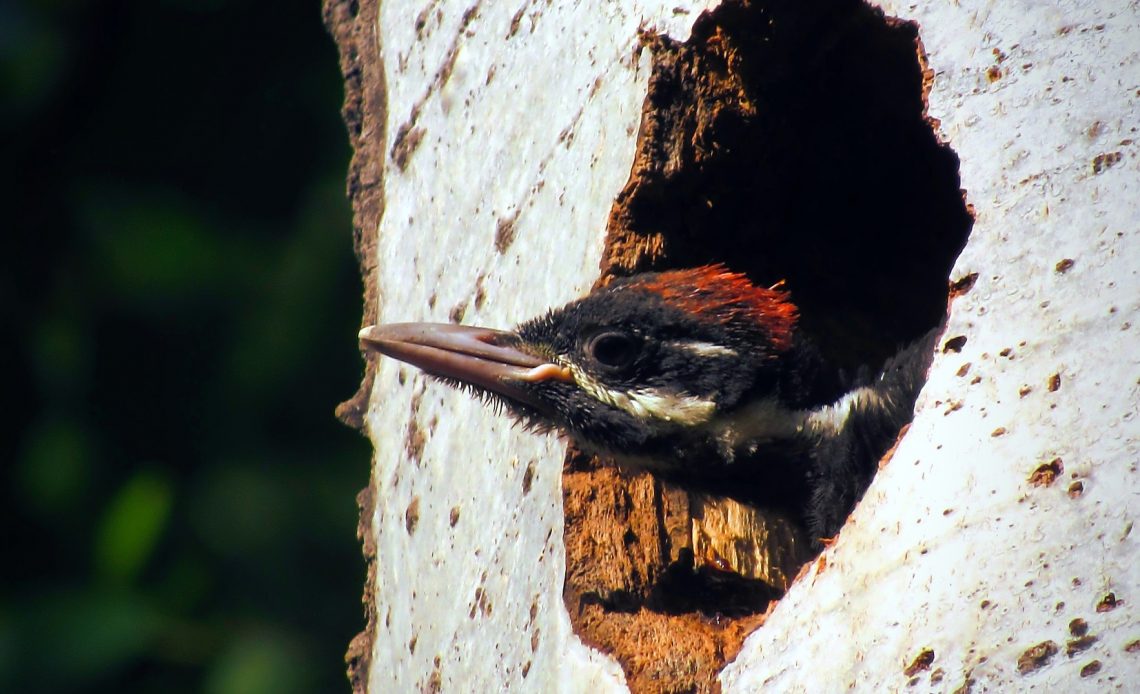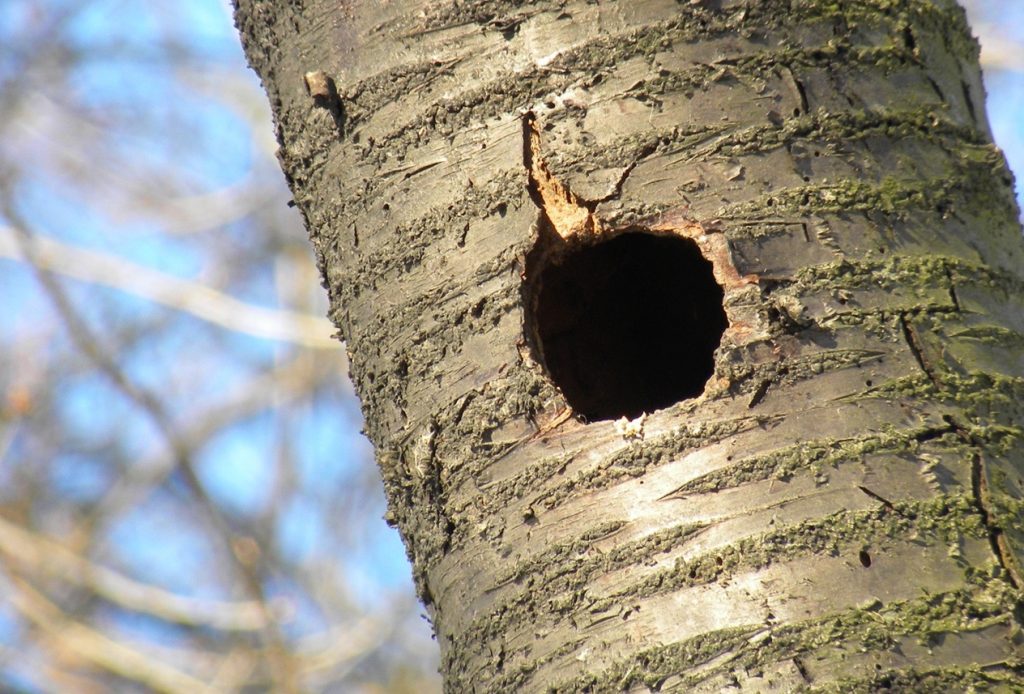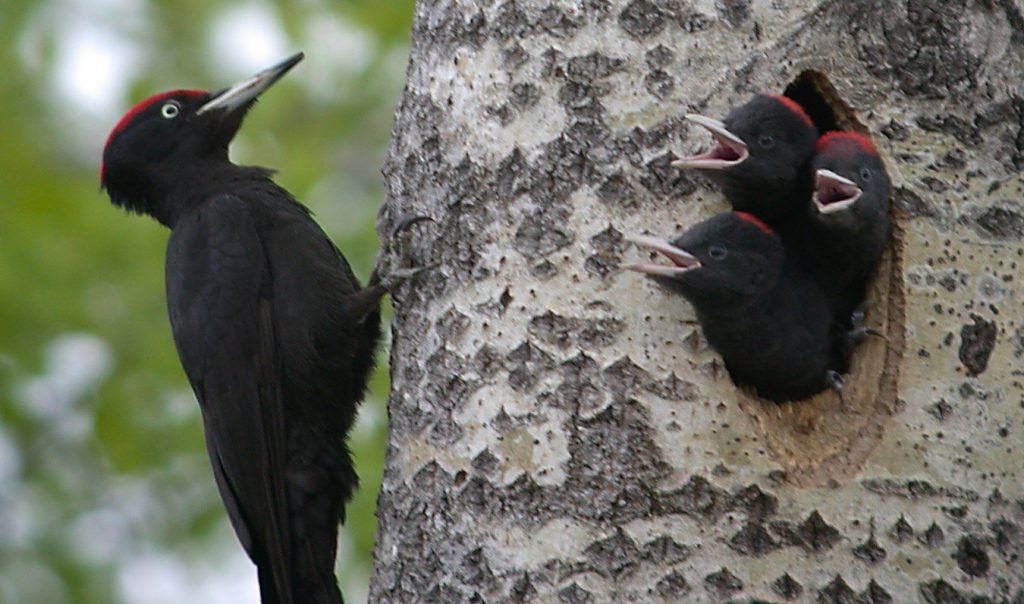

We’re here to help! Wild Yards is a completely free website that is 100% dedicated to helping you create a wildlife-friendly, sustainable yard. Read more
WildYards is reader-supported. When you buy a product through a link on our site, we may earn a comission. Every product is independently selected by our (obsessive) editors and our reviews are unbiased and objective. Read more about our mission or our privacy policy.
Woodpeckers are highly industrious little birds, and as you may already know, they can make a lot of noise about creating nests! Given that woodpecker eggs are so precious and make for prime predator feed, it’s only reasonable that their parents are likely to be so protective.
In this guide, you’ll find out everything you need to know about woodpecker nests – what they look like, where you’ll find them, how they make them, and how long they’re typically used for.
What does a woodpecker nest look like?
Unlike many other birds’ nests, woodpecker nests are not out in the open. They are normally built and used inside the hollows of dead trees. Dead trees are not only easier for woodpeckers to hammer into, but they are also less likely to attract predators and other animals (barring the odd tasty insect). A clear sign of a woodpecker nest is a circular hole – and a nest will typically sit around a foot deep into the cavity.
Therefore, to get a good look at a woodpecker nest, you need to look inside the drilled holes of a dead or dying tree. Often, woodpecker nests are fairly simple, with a single chamber offering a soft, warm flooring of bark chips and other materials woodpeckers will find while pecking and hunting. Mom and Dad woodpeckers will raise their eggs in this hole (and yes, they even take it in turns to babysit!).
How big is a woodpecker nest?
The size of a woodpecker’s nest will vary – as they can choose decaying trees of varying sizes. As mentioned, a drop of around a foot from within the circular drilled opening isn’t unheard of. This is certainly common to the downy woodpecker, for example. However, some species, such as the pileated woodpecker, may double the drop.
Where do woodpeckers make their nests?
Woodpeckers commonly carve out and place their nests in decaying, hollow trees or in stumps. They opt for solid, thick-barked, hollowed trees to provide the right amount of space and insulation for their eggs over a month of raising and incubation. You can usually find them in oak trees, pines, maples, birches, and cottonwoods.
Dead wood and stumps, again, are easy to peck into. They also provide a healthy supply of bugs and insects over time. Given that nesting normally only lasts up to a month for woodpecker young, these birds will only ever use the shells of trees for short periods.
You’ll rarely find a woodpecker killing a tree or pecking a nest into a healthy specimen. This tends to only be the case if there are few options elsewhere.

How do woodpeckers make their nests?
Woodpeckers make their nest entrances by repeatedly pecking into the wood of preferred, hollow trees. Interestingly, it is not just the male of the species that makes the nests, but also the female.
Different woodpeckers also make nests of different shapes, from round to oval and even gourd-shaped. They line the inside of their nests with materials they are likely to come across while pecking – woodchip, for example, is a common nest lining, as is sawdust, grass, and pieces of branches.
How long does it take woodpeckers to build their nests?
The length of time it takes the woodpeckers to make their nests depends on the size of the hole they are drilling and the type of wood they are pecking into. Of course, the stronger the tree, the longer it will take them. That is why they favor dead trees, as it is easier to get into the wood.
However, generally speaking, it will take a pair of woodpeckers around three weeks to a month to build a nest. On top of this, egg incubation won’t take longer than two weeks.
How long do woodpeckers stay in their nests for?
Young woodpeckers stay in their nests for about three weeks after hatching. After that, the parents will chase them away from the nest!
Adult woodpeckers tend to stay in their nest for their roosting period and leave shortly after. However, some woodpecker species have been known to return to their very same nest year after year. If it is in a good spot, then why move?
Woodpecker nests can also get taken over by other birds, often leaving them to have to make their homes somewhere else.
Other woodpecker species naturally change the location of their nests every year. As mentioned, nesting is generally fairly brief for woodpeckers, and hollowed trees normally give them the space and warmth they need temporarily.

How do you spot a woodpecker nest?
While sounds of local wood drilling and hammering normally give nesting behavior away, it is not always simple to spot a woodpecker’s nest with the naked eye. Nest entrances tend to be quite small, and therefore if they are high up in the hollow of a tree, you will need binoculars to spot them!
Otherwise, look for trees or trunks in your local area that are decaying, dead, or are reduced to stumps. If there is an abundance of insect, bug, or fungal activity, then it’s likely a woodpecker will earmark it as a great nesting location.
If you want to go hunting for woodpecker nests, the best thing to do is be patient. Grab a pair of binoculars, and wait silently for birds to flit between the same trees. If you’ve heard wood pecking for weeks, then this added behavior will all but confirm there’s a nest.
Can I help build a woodpecker nest?
It is never a good idea to tamper with a woodpecker’s pre-built nest, especially given that woodpeckers are protected in the US, and that – these birds take weeks out of their life to drill into very specific spots! It’s a laborious process, and woodpeckers know best.
However, that isn’t to say that giving them a helping hand is entirely out of the question. Some conservationists suggest using cavity inserts in suitable trees to help encourage threatened species. This may be as simple as inserting nesting boxes into local bark, giving the appearance of a typical woodpecker nesting site.
Conclusion
Woodpeckers won’t keep you up at night with their nest-building, but they do work tirelessly to provide for their young. Woodpecker nesting sites are exciting to behold if you watch them from afar.
If you are already keen to attract woodpeckers to your yard, it’s worth keeping an ear or two out to see whether or not families are being raised in your area. Once you know a nest or two is nearby, it’s time to fill up the woodpecker feeder and to enjoy these beautiful animals in your own outdoor theater.

If I clean it out after the nesting season is over, will Downy woodpeckers reuse the nest hole next year?
I need to remove a tree from my yard but the woodpeckers stay in this tree all the time. If I cut it down will the birds leave the area, or will they stay and find another tree? We love to watch them.
Hi Lydia,
Typically, if the woodpeckers have a reliable food source nearby they will simply move to another tree close by.
I have a large oak tree and there is a dead stump from a fallen branch that a Red-Bellied Woodpecker has decided to make her home. The rest of the tree seems to be in fine condition and I don’t see any damage. Is there any harm in having them nest in this part of the tree? I just started putting birdfeeders out this year so I think they like this. (I have many photos and videos I can share if need be)
Hi Julie,
There’s no harm in having them nest in dead stump. Woodpeckers prefer hollowed out, decaying stumps of wood for their nests so as long as you are providing a reliable source of food for them – they should be happy and content where they are!
Is there any way to protect a downy woodpecker nest from aerial predators such as magpies ?
Hi, I just had this, to me a red headed woodpecker making a nest in a dieing oak limb. This went on for 2 weeks, give or take. Only saw one. It was always getting on the ground, I think for food. Then it was gone. Looked around to see if feral cat may have gotten it no signs of that. Thankfully, is it common for this or do you think it may have been killed. Tree to high for me to climb to see if eggs are in nest. Maybe it just decided to move on or just the male and the female was building it somewhere else. This looked to be a rare one as I never seen one around this area. 28 years here. Midland City, Alabama.
We found a baby and put him back but was also trying to be dependent when was not able. Do woodpeckers build doors?
Currently have a woodpecker making a nest in a dead tree that will need to be removed soon before it falls. What should I do?! Also there are surrounding trees that need heavy pruning or removal, how can I protect the nest?
A woodpecker is pecking on the wood inside the framework of my house. It’s been going on for the last three weeks or so. It’s very cold here in Atlanta and from reading up about woodpeckers, seems out of season for them to be nesting. The pecking is very loud and is near one of the bedrooms of the house. I’m concerned that they will peck through the wall if given the opportunity. Since they are a protected species, is there are city service that could come and relocate the nest in the Atlanta area that you are aware of? Weather temperature is 56 degrees today, up from 26 degrees earlier.
Help!